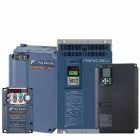In general, circuit breakers protect electrical circuits from overcurrent and short circuits. They come in different shapes and sizes. Examples include Miniature Circuit Breakers (MCB), Molded Case Circuit Breakers (MCCB), Air Circuit Breakers (ACB), and Vacuum Circuit Breakers (VCB). Among these, the Molded Case Circuit Breaker (MCCB) is a key player in ensuring electrical safety.
What is an MCCB, or Molded Case Circuit Breaker?
A Molded-Case Circuit Breaker, or MCCB, houses all its components inside an insulating molded case. These circuit breakers are often found in commercial, industrial, and even some high-power homes.
Think of them as reliable workhorses for electrical protection. MCCBs typically feature adjustable trip settings. They also handle higher current ratings than MCBs, making them suitable for higher-voltage applications.
Now, you might be wondering how these things work. Let’s break down the components and operation.
MCCB Components and Operation
An MCCB consists of several key parts that protect electrical circuits.
Frame
The sturdy outer shell provides insulation and structural support.
Operating Mechanism
This allows you to turn the circuit breaker on and off manually. It also automatically trips the breaker under fault conditions.
Arc Extinguishing System
This critical component quenches the arc that forms when the circuit breaker interrupts a high current. This prevents damage and ensures safe operation.
Trip Unit
The brains of the operation. It senses overloads and short circuits. It then triggers the operating mechanism to trip the breaker. There are two main types: thermal-magnetic and electronic.
Speaking of trip units, let’s clarify what each one does. Thermal-magnetic trip units find short circuits and overloads using a bimetallic strip and an electromagnet. They’re reliable and cost-effective.
Conversely, electronic trip units offer more precise and adjustable protection settings, allowing for greater customization and control.
The MCCB operates by interrupting a circuit when it detects an overload or a short circuit. When the current exceeds the set limit, the trip unit activates. The operating mechanism then trips, breaking the circuit and stopping the flow of electricity.
Advantages of Using MCCBs
MCCBs provide several benefits that make them essential for many electrical systems.
Enhanced Protection
They offer better protection against overloads and short circuits compared to MCBs.
Adjustability
Their adjustable trip settings allow customization based on specific circuit needs.
Higher Ratings
They handle higher current and voltage demands effectively.
Reliability
Their strong design means they will work reliably even in harsh conditions.
Flexibility
MCCBs can be used in various applications, from industrial machinery to commercial buildings.
Disadvantages of Using MCCBs
Despite their many advantages, MCCBs have some drawbacks.
Cost
They are generally more expensive than MCBs.
Size
They tend to be larger than MCBs, requiring more space in your panel.
Complexity
Their more complex design may require specialized knowledge for installation and maintenance.
Applications of MCCBs
MCCBs can be used in many different industries in many different ways.
Industrial
They provide power distribution in factories and protect machinery. For example, MCCBs safeguard against overloads that could damage expensive equipment in manufacturing plants.
Commercial
MCCBs are used in commercial buildings, data centers, and large retail spaces. They protect against electrical faults and ensure continuous operation.
Renewable Energy
They integrate into solar power and wind turbine installations, helping ensure reliable energy production and protecting the systems from electrical surges.
Other High-Power Applications
They suit any application needing strong overcurrent protection at higher current levels, including large residential complexes and high-power electrical systems.
Related Components and Systems
MCCBs often form complete systems by collaborating with other electrical components. According to FESP, MCCBs can protect Low-Voltage Variable-Speed Drives (LV VSD) and Medium-Voltage Variable-Speed Drives (MV VSD).
MCCBs are also used with Uninterruptible Power Supplies (UPS) and Power Conditioner Systems (PCS). They protect transformers, including oil-immersed and cast resin types.
Pro tip: When selecting an MCCB, always consider your application’s specific requirements. Factor in current, voltage, and any specific protection needs. Over-specifying can be expensive, and under-specifying can be dangerous. For instance, if you’re setting up a new industrial facility, ensure that your MCCBs are rated for the maximum expected load to prevent frequent tripping.
Frequently Asked Questions
What is the difference between a power circuit breaker and a molded case circuit breaker?
Power circuit breakers are usually larger and used for higher voltage and current applications. They often have more advanced features and are used in substations and main distribution panels. MCCBs, on the other hand, are typically used for lower voltage and current applications in distribution boards and individual circuits.
What is the difference between MCCB and MCB?
MCBs (Miniature Circuit Breakers) are for lower-current residential and light commercial applications. MCCBs (Molded-Case Circuit Breakers) are for higher-current industrial and commercial applications and offer adjustable trip settings.
What is the life expectancy of a molded case circuit breaker?
The life expectancy of an MCCB depends on usage and environmental conditions. However, they’re generally designed for 20-30 years of service. Regular inspection and testing are essential to ensure their correct function.
In what ways do moulded case circuit breakers and air circuit breakers differ?
MCCBs use a molded case for insulation and protection. Meanwhile, ACBs (Air Circuit Breakers) use air as the insulating medium for arc extinction. ACBs are typically used for higher current and voltage applications than MCCBs.
What are the disadvantages of MCCB?
They are more prominent, cost more than MCBs, and have a complex design that may require specialized knowledge for installation and maintenance.
Pro-Tip: Regular maintenance is key to ensuring the longevity and reliability of your MCCBs. Set up regular testing and inspections to find and fix problems before they become big. For example, checking the trip unit and ensuring proper connections can prevent unexpected shutdowns.
Molded Case Circuit Breakers are critical components for protecting electrical systems. They offer enhanced protection, adjustability, and reliability for various applications. While they have some drawbacks, the advantages generally outweigh the disadvantages, especially in demanding industrial and commercial settings.
Choosing the right MCCB, installing it correctly, and maintaining it will ensure reliable circuit protection for years. Whether setting up a new facility or upgrading one, MCCBs are a solid choice for safeguarding your electrical systems.
About Fuji Electric Sales Philippines, Inc.
Fuji Electric Sales Philippines, Inc. is proud to represent Fuji Electric Co., Ltd. from Japan in the Philippines. The company leads the promotion, sales, and support of energy-saving technologies, automation systems, and power electronics to support industries and infrastructure.
Looking to enhance your automation systems with a molded case circuit breaker? Get in touch with Fuji Electric:
Rickson Manalo
Assistant Sales Manager
0917-115 6102








